KIA Sorento 2007 1.G Workshop Manual
Manufacturer: KIA, Model Year: 2007, Model line: Sorento, Model: KIA Sorento 2007 1.GPages: 325, PDF Size: 5.01 MB
Page 51 of 325

Knowing your vehicle42
33. Pull the shoulder portion of the safety
belt all the way out. When the shoulder
portion of the safety belt is fully
extended, it will shift the retractor to
the “Auto Lock” (child restraint) mode. 4. Slowly allow the shoulder portion of
the safety belt to retract and listen for
an audible “clicking” or “ratcheting”
sound. This indicates that the retractor
is in the “Auto Lock” mode. If no distinct
sound is heard, repeat steps 3 and 4. 5. Remove as much slack from the belt
as possible by pushing down on the
child restraint system while feeding the
shoulder belt back into the retractor.
6. Push and pull on the child restraint system to confirm that the safety belt is
holding it firmly in place. If it is not,
release the safety belt and repeat
steps 2 through 6.
MMSA3028
"Click"
MMSA3029
MMSA3030
Page 52 of 325
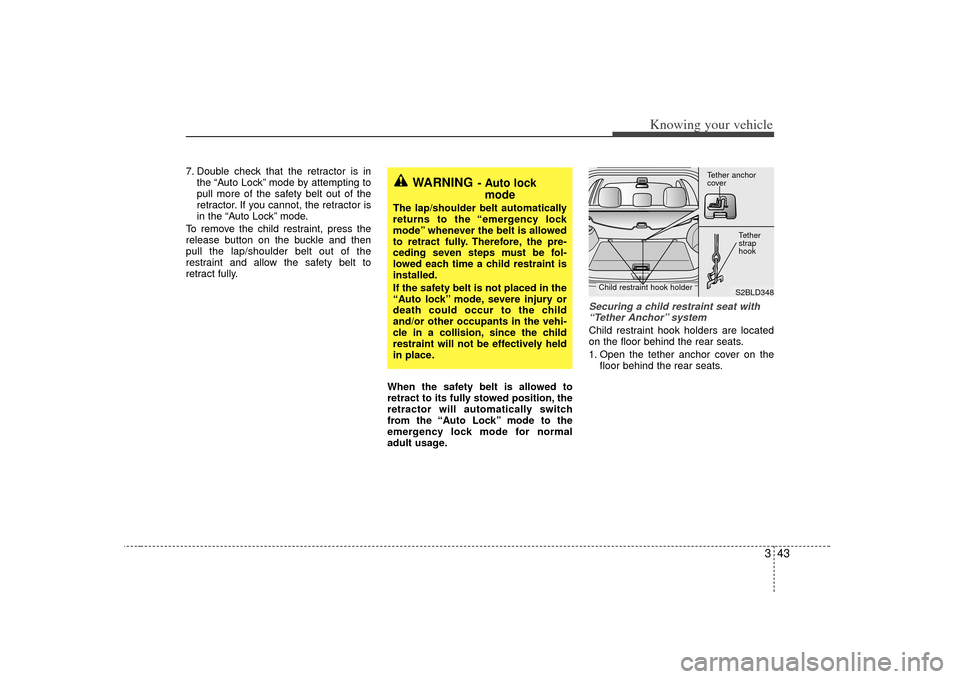
343
Knowing your vehicle
7. Double check that the retractor is inthe “Auto Lock” mode by attempting to
pull more of the safety belt out of the
retractor. If you cannot, the retractor is
in the “Auto Lock” mode.
To remove the child restraint, press the
release button on the buckle and then
pull the lap/shoulder belt out of the
restraint and allow the safety belt to
retract fully.
When the safety belt is allowed to
retract to its fully stowed position, the
retractor will automatically switch
from the “Auto Lock” mode to the
emergency lock mode for normal
adult usage.
Securing a child restraint seat with“Tether Anchor” system Child restraint hook holders are located
on the floor behind the rear seats.
1. Open the tether anchor cover on the floor behind the rear seats.
WARNING
- Auto lockmode
The lap/shoulder belt automatically
returns to the “emergency lock
mode” whenever the belt is allowed
to retract fully. Therefore, the pre-
ceding seven steps must be fol-
lowed each time a child restraint is
installed.
If the safety belt is not placed in the
“Auto lock” mode, severe injury or
death could occur to the child
and/or other occupants in the vehi-
cle in a collision, since the child
restraint will not be effectively held
in place.
S2BLD348
Tether anchor
coverTether
strap
hook
Child restraint hook holder
Page 53 of 325
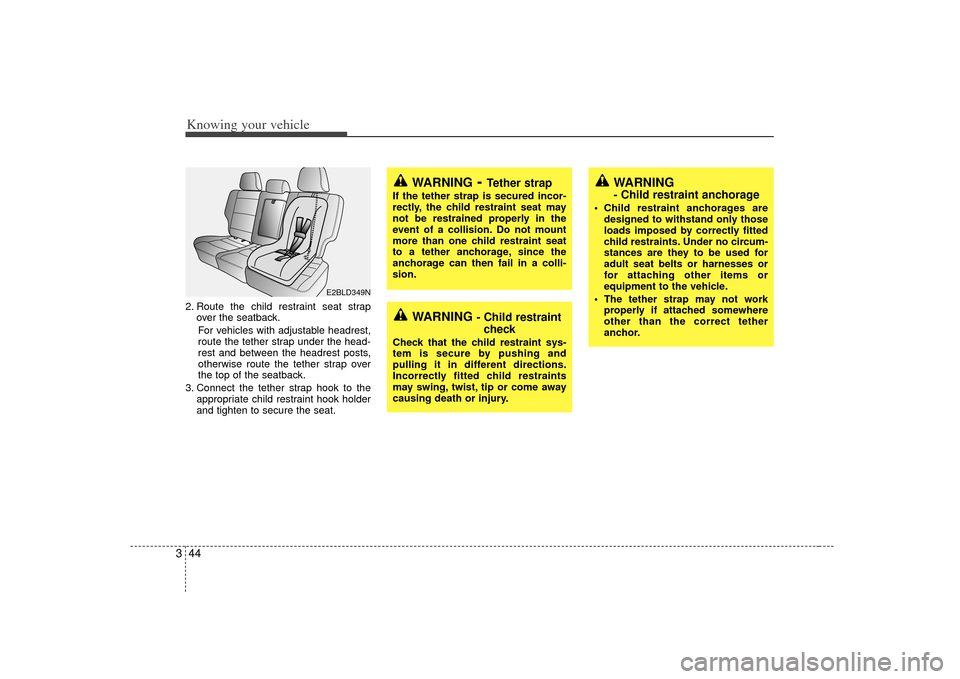
Knowing your vehicle44
32. Route the child restraint seat strap
over the seatback.
For vehicles with adjustable headrest,
route the tether strap under the head-
rest and between the headrest posts,
otherwise route the tether strap over
the top of the seatback.
3. Connect the tether strap hook to the appropriate child restraint hook holder
and tighten to secure the seat.
WARNING
- Tether strap
If the tether strap is secured incor-
rectly, the child restraint seat may
not be restrained properly in the
event of a collision. Do not mount
more than one child restraint seat
to a tether anchorage, since the
anchorage can then fail in a colli-
sion.
WARNING
- Child restraintcheck
Check that the child restraint sys-
tem is secure by pushing and
pulling it in different directions.
Incorrectly fitted child restraints
may swing, twist, tip or come away
causing death or injury.
WARNING - Child restraint anchorage
Child restraint anchorages are
designed to withstand only those
loads imposed by correctly fitted
child restraints. Under no circum-
stances are they to be used for
adult seat belts or harnesses or
for attaching other items or
equipment to the vehicle.
The tether strap may not work properly if attached somewhere
other than the correct tether
anchor.
E2BLD349N
Page 54 of 325

345
Knowing your vehicle
Child seat lower anchorsSome child seat manufacturers make
child restraint seats that are labeled as
LATCH or LATCH compatible. LATCH
stands for "Lower Anchors and Tethers
for Children". These seats include two
rigid or webbing mounted attachments
that connect to two LATCH anchors at
specific seating positions in your vehicle.
This type of child restraint seat elimi-
nates the need to use seat belts to attach
the child seat in the rear seats.LATCH anchors have been provided in
your vehicle. The LATCH anchors are
located in the left and right outboard rear
seating positions. Their locations are
shown in the illustration. There is no
LATCH anchor provided for the center
rear seating position.
The LATCH anchors are located between
the seatback and the seat cushion of the
rear seat left and right outboard seating
positions.
Follow the child seat manufacturer’s
instructions to properly install child
restraint seats with LATCH or LATCH-
compatible attachments.Once you have installed the LATCH child
restraint, assure that the seat is properly
attached to the LATCH and tether
anchors. Also, test the child restraint seat
before you place the child in it. Tilt the
seat from side to side. Also try to tug the
seat forward. Check to see if the anchors
hold the seat in place.
1KMB3541
S2BLC354/OBL036904N
Page 55 of 325
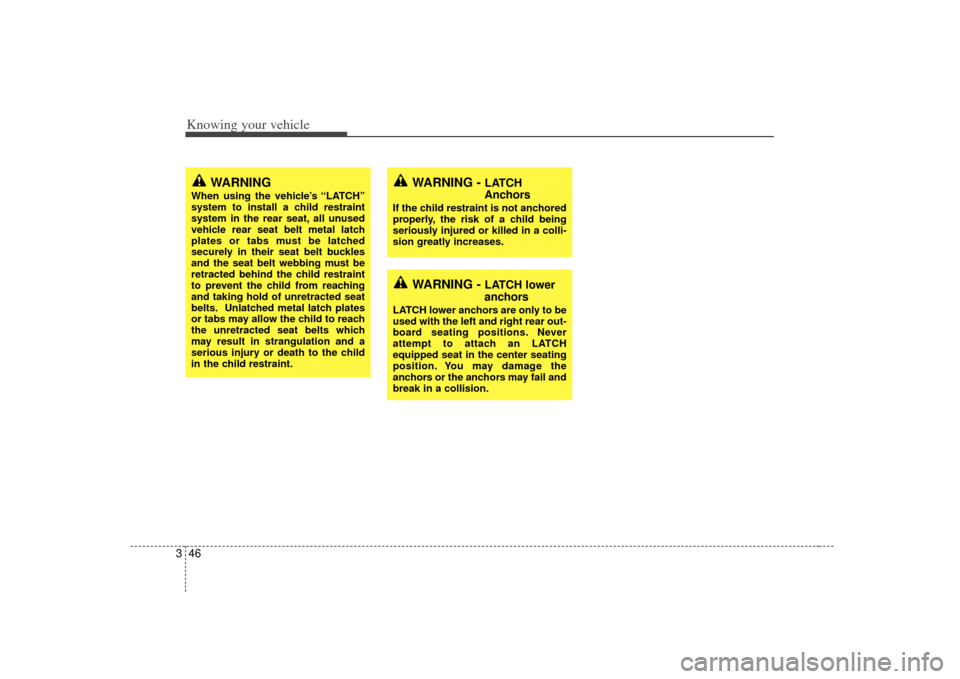
Knowing your vehicle46
3
WARNING -
LATCH
Anchors
If the child restraint is not anchored
properly, the risk of a child being
seriously injured or killed in a colli-
sion greatly increases.
WARNING
When using the vehicle’s “LATCH”
system to install a child restraint
system in the rear seat, all unused
vehicle rear seat belt metal latch
plates or tabs must be latched
securely in their seat belt buckles
and the seat belt webbing must be
retracted behind the child restraint
to prevent the child from reaching
and taking hold of unretracted seat
belts. Unlatched metal latch plates
or tabs may allow the child to reach
the unretracted seat belts which
may result in strangulation and a
serious injury or death to the child
in the child restraint.
WARNING -
LATCH lower
anchors
LATCH lower anchors are only to be
used with the left and right rear out-
board seating positions. Never
attempt to attach an LATCH
equipped seat in the center seating
position. You may damage the
anchors or the anchors may fail and
break in a collision.
Page 56 of 325
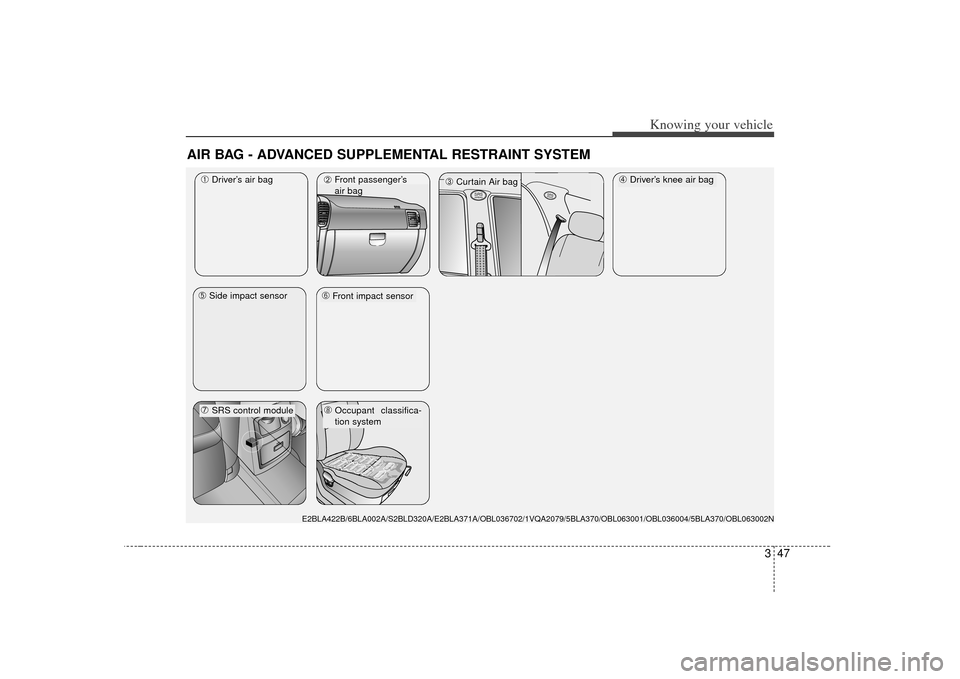
347
Knowing your vehicle
AIR BAG - ADVANCED SUPPLEMENTAL RESTRAINT SYSTEM
SRSAIRBAG
➀Driver’s air bag
➃Driver’s knee air bag
➁Front passenger’s
air bag
➂Curtain Air bag
\bFront impact sensor
➆ SRS control module
E2BLA422B/6BLA002A/S2BLD320A/E2BLA371A/OBL036702/1VQA2079/5BLA370/OBL063\
001/OBL036004/5BLA370/OBL063002N
➄Side impact sensor
➇Occupant classifica-
tion system
SRSAIR BAG
Page 57 of 325

Knowing your vehicle48
3
WARNING
- Air bags &
safety belts
Even in vehicles with air bags,
you and your passengers must
always wear the safety belts pro-
vided in order to minimize the risk
and severity of injury in the event
of a collision or rollover.
Always wear your safety belt. It can help keep you away from the
air bags during heavy braking
just before a collision. It may also
reduce the risk of occupant ejec-
tion.
If vehicle occupants are not wear- ing their seatbelts properly, or are
not seated correctly, serious
injury or death could occur.
Driver’s and front passenger’s air bags are designed to inflate only
in certain frontal collisions, and
curtain air bags are designed to
inflate in certain side impacts.
(Continued)
What your air bag system doesDriver’s air bag and front passenger’s air
bag are designed to supplement the pro-
tection offered by the safety belt in cer-
tain frontal collisions. Likewise, curtain air
bags are designed to supplement the
protection offered by the safety belt in
side collisions. Safety belts are designed
to reduce the injury of the driver or pas-
sengers in case of light impact or colli-
sion. However, to help reduce impact on
driver or passengers in a serious colli-
sion, seat belts must also be worn cor-
rectly.What your air bag system does
not doThe air bag system is designed to sup-
plement the protection offered by the
safety belt system. IT IS NOT A SUBSTI-
TUTE FOR THE SAFETY BELT.
The importance of using safety
beltsThere are four very important reasons to
use safety belts even with an air bag
supplemental restraint system. They:
help keep you in the proper position(away from the air bag) when it inflates.
reduce the risk of harm in rollover, side impact or rear impact collisions,
because an air bag is not designed to
inflate in such situations and even a
side curtain air bag is designed to
inflate only in certain side impact colli-
sions.
reduce the risk of harm in frontal or side collisions which are not severe
enough to actuate the air bag supple-
mental restraint system.
reduce the risk of being thrown from your vehicle.
Page 58 of 325
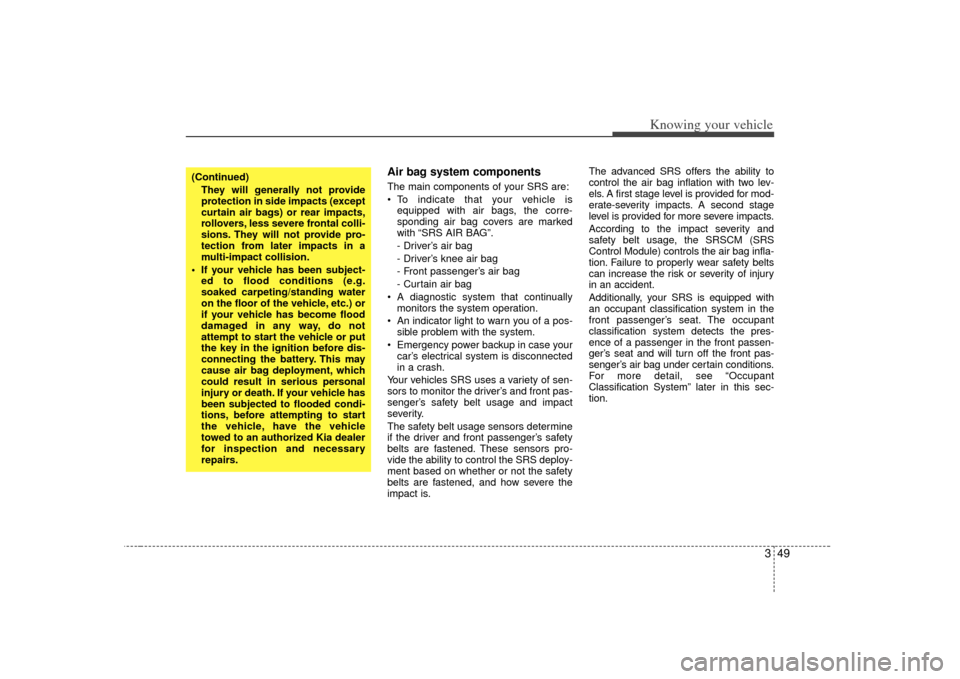
349
Knowing your vehicle
Air bag system components The main components of your SRS are:
To indicate that your vehicle isequipped with air bags, the corre-
sponding air bag covers are marked
with “SRS AIR BAG”.
- Driver’s air bag
- Driver’s knee air bag
- Front passenger’s air bag
- Curtain air bag
A diagnostic system that continually monitors the system operation.
An indicator light to warn you of a pos- sible problem with the system.
Emergency power backup in case your car’s electrical system is disconnected
in a crash.
Your vehicles SRS uses a variety of sen-
sors to monitor the driver’s and front pas-
senger’s safety belt usage and impact
severity.
The safety belt usage sensors determine
if the driver and front passenger’s safety
belts are fastened. These sensors pro-
vide the ability to control the SRS deploy-
ment based on whether or not the safety
belts are fastened, and how severe the
impact is. The advanced SRS offers the ability to
control the air bag inflation with two lev-
els. A first stage level is provided for mod-
erate-severity impacts. A second stage
level is provided for more severe impacts.
According to the impact severity and
safety belt usage, the SRSCM (SRS
Control Module) controls the air bag infla-
tion. Failure to properly wear safety belts
can increase the risk or severity of injury
in an accident.
Additionally, your SRS is equipped with
an occupant classification system in the
front passenger’s seat. The occupant
classification system detects the pres-
ence of a passenger in the front passen-
ger’s seat and will turn off the front pas-
senger’s air bag under certain conditions.
For more detail, see “Occupant
Classification System” later in this sec-
tion.
(Continued)
They will generally not provide
protection in side impacts (except
curtain air bags) or rear impacts,
rollovers, less severe frontal colli-
sions. They will not provide pro-
tection from later impacts in a
multi-impact collision.
If your vehicle has been subject- ed to flood conditions (e.g.
soaked carpeting/standing water
on the floor of the vehicle, etc.) or
if your vehicle has become flood
damaged in any way, do not
attempt to start the vehicle or put
the key in the ignition before dis-
connecting the battery. This may
cause air bag deployment, which
could result in serious personal
injury or death. If your vehicle has
been subjected to flooded condi-
tions, before attempting to start
the vehicle, have the vehicle
towed to an authorized Kia dealer
for inspection and necessary
repairs.
Page 59 of 325
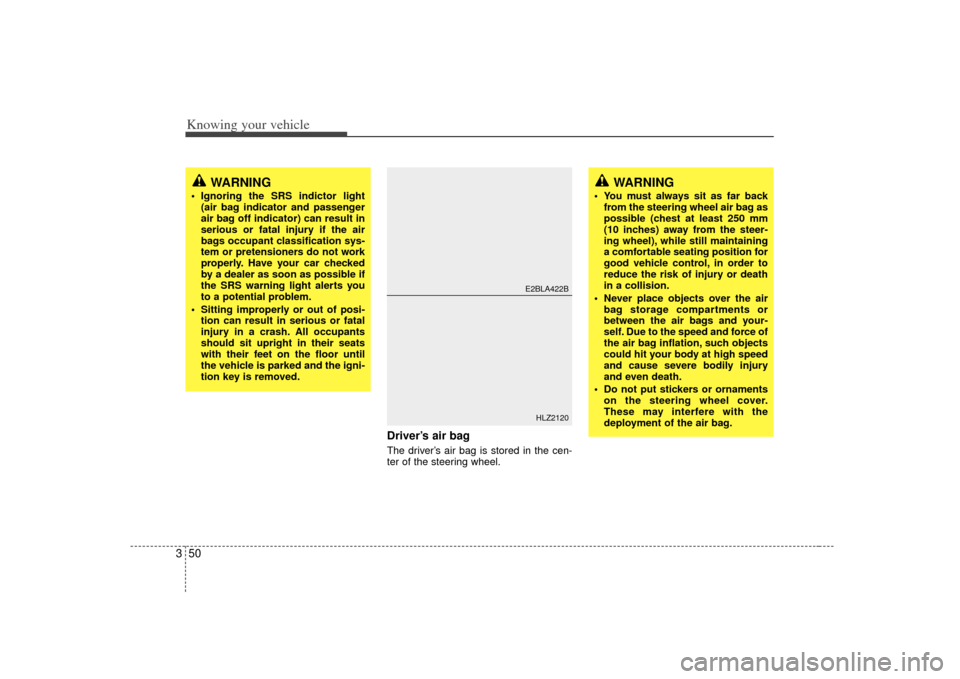
Knowing your vehicle50
3
Driver’s air bagThe driver’s air bag is stored in the cen-
ter of the steering wheel.
WARNING
Ignoring the SRS indictor light
(air bag indicator and passenger
air bag off indicator) can result in
serious or fatal injury if the air
bags occupant classification sys-
tem or pretensioners do not work
properly. Have your car checked
by a dealer as soon as possible if
the SRS warning light alerts you
to a potential problem.
Sitting improperly or out of posi- tion can result in serious or fatal
injury in a crash. All occupants
should sit upright in their seats
with their feet on the floor until
the vehicle is parked and the igni-
tion key is removed.
E2BLA422BHLZ2120
WARNING
You must always sit as far backfrom the steering wheel air bag as
possible (chest at least 250 mm
(10 inches) away from the steer-
ing wheel), while still maintaining
a comfortable seating position for
good vehicle control, in order to
reduce the risk of injury or death
in a collision.
Never place objects over the air bag storage compartments or
between the air bags and your-
self. Due to the speed and force of
the air bag inflation, such objects
could hit your body at high speed
and cause severe bodily injury
and even death.
Do not put stickers or ornaments on the steering wheel cover.
These may interfere with the
deployment of the air bag.
Page 60 of 325

351
Knowing your vehicle
Driver's knee air bagThe driver's knee air bag is stored below
the steering wheel of the instrument
panel.
This works in conjunction with the frontal
airbags in a certain frontal impact colli-
sion to protect the knee of the driver.
Front passenger’s air bagThe front passenger’s air bag is stored in
the instrument panel, above the glove
box area.
Since you cannot anticipate which air
bags will deploy or from what direction,
never put any objects or ornaments on
the instrument panel.
Occupant classification systemThe occupant classification system
detects the presence of a passenger in
the front passenger's seat and will turn
off the front passenger's air bag under
certain conditions.
The occupant classification system is
designed to detect the presence of a
properly-seated occupant and determine
if the front passenger's air bag should be
enabled (may inflate) or not.
Only the front passenger front air bag is
controlled by the Occupant Classification
System.
6BLA002AHLZ2121
5BLA370
OBL036702OBL036700N